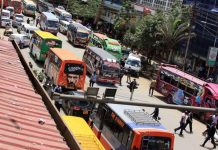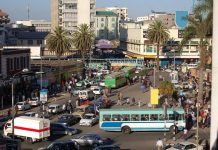Things are looking up for Mombasa port as a modernisation project and the Standard Gauge Railway (SGR) bring in more cash.
The port earned Sh45.35 billion in 2018, an increase of Sh4 billion over the previous year’s Sh41.56 billion, as it handled a slightly higher number of containers.
According to the Kenya Ports Authority (KPA) financials for 2018, profit before tax for 2018 dropped marginally from Sh10.6 billion to Sh10.3 billion, largely as a result of an increase in expenditure.
MODERNISATION
With the five-year modernisation project, which entailed dredging the port channel and constructing Berth 19, the port has increased its capacity to handle bigger panmax (382 metres) vessels, and the upgrade of the cargo evacuation equipment saw it lower ship occupancy time from five to 1.55 days in 2017.
This means KPA can now expect to see growth in cargo volumes, and especially once the second container terminal under construction is complete.
This will increase the port’s container capacity by 450,000 twenty-foot equivalent unit (TEU’s), further cementing the port as the region’s logistics hub.
The ports grants from the government rose to Sh5 billion last year, up from 588 million the previous year, as the country intensified the port’s modernisation to bring it to par with its competitors, including Durban, Egypt and Lagos ports.
CARGO
The push to have importers use the SGR and pick their cargo from the Nairobi Inland Container Depot in Embakasi also breathed life into the previously lacklustre facility, pushing its handling capacity last year to 257,972 TUEs in 2017.
According to a KPA report, last year, the Embakasi ICD handled 177, 652 TUES imported into the county, up from 15,110 units in 2017. The depot also saw a rise on the Empty units heading back to the Mombasa port from the depot stood at 68,619 units, up from 10,636 in 2017. In September, Kenya Railways completed the port relief line to the conventional cargo berth, and also announced that it will allow businessmen to extend the line to their premises.
The report also shows that the port recorded marginal growth, driven by the rise in containerised cargo. It handled 30.92 million tonnes of cargo, up from 30.34 million in 2017, driven by a 10 per cent increase in the containerised cargo.
SOURCE: nation.co.ke








![Top 20 Used Cars to Avoid Buying in Kenya – [PHOTOS]](../../../blog/wp-content/uploads/2013/11/top-used-unreliable-cars-to-avoid2-80x60.jpg)

![Top 20 Used Cars to Avoid Buying in Kenya – [PHOTOS]](../../../blog/wp-content/uploads/2013/11/top-used-unreliable-cars-to-avoid2-100x70.jpg)





